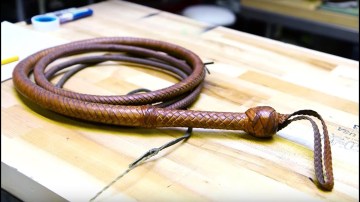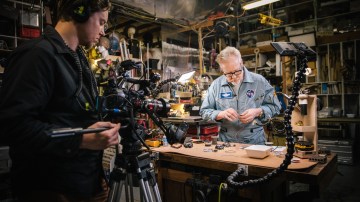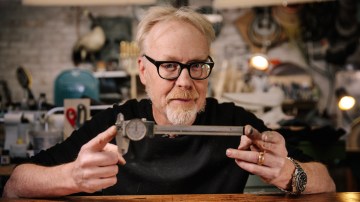Shop Tips: How To Pour from Large Containers
We’re starting a new series this week with effects artist Frank Ippolito: Shop Tips! Frank shares his favorite tools, techniques, and processes that he’s acquired over the years running his own effects and fabrication shop. This week, we kick off with a seemingly simple task: pouring liquid material out of one gallon and five gallon containers.
Shot and edited by Joey Fameli
30 thoughts on “Shop Tips: How To Pour from Large Containers”
Leave a Reply

One Day Builds
Adam Savage’s One Day Builds: Life-Size Velocirapt…
Adam embarks on one of his most ambitious builds yet: fulfil…

Show And Tell
Adam Savage’s King George Costume!
Adam recently completed a build of the royal St. Edwards cro…
All Eyes On Perserverance – This is Only a Test 58…
We get excited for the Perserverance rover Mars landing happening later today in this week's episode. Jeremy finally watches In and Of Itself, we get hyped for The Last of Us casting, and try to deciper the new Chevy Bolt announcements. Plus, Kishore gets a Pelaton and we wrack our brains around reverse engineering the source code to GTA …

One Day Builds
Mandalorian Blaster Prop Replica Kit Assembly!
Adam and Norm assemble a beautifully machined replica prop k…
House of MCU – This is Only a Test 586 – 2/11/21
The gang gets together to recap their favorite bits from this past weekend's Superb Owl, including the new camera tech used for the broadcast and the best chicken wing recipes. Kishore shares tips for streamlining your streaming services, and Will guests this week to dive into the mind-bending implications of the latest WandaVision episod…

One Day Builds
Adam Savage’s One Day Builds: Royal Crown of Engla…
One of the ways Adam has been getting through lockdown has b…

Making
Adam Savage Tests the AIR Active Filtration Helmet…
Adam unboxes and performs a quick test of this novel new hel…

Making
Weta Workshop’s 3D-Printed Giant Eyeballs!
When Adam visited Weta Workshop early last year, he stopped …

One Day Builds
Adam Savage’s One Day Builds: Wire Storage Solutio…
Adam tackles a shop shelf build that he's been putting off f…

Show And Tell
Mechanical Dragonfly Automata Kit Build and Review
Time for a model kit build! This steampunk-inspired mechanic…


























Wow… Had no idea. Makes so much sense.
I am really looking forward to different series like this. They are by far my favorite items on the website. No matter how much you know you can always learn more. Fun to see how other people handle different tasks/challenges.
Jimmy Diresta also has some pretty awesome tip videos on his youtube channel that are in a similar vein to this video. Here’s his playlist:
https://www.youtube.com/watch?v=9kyLY1xWrCI&list=PLnbHUsOu-Nfvc2bTj2FWiyzrOs_UkVxZH
My wife asked me once if there was any way I could recycle the dust from sanding and smoothing out Bondo, since I make a ton of it. Sometime later, I tried packing some bondo dust into a big void in a prop I was making, and then soaked it in super glue. The result was an instant-set filler! It’s not good for smoothing big surfaces, but if you need to fill a big void or reshape a nicked corner, it’s a great time saver and the result is a rock-hard repair. So my shop tip is to collect some of the sanding dust you sweep up (or collect in a dust-collection unit) and use it with super glue for a quick and dirty (literally!) filler. Beats waiting on store-bought filler putty to cure.
I will have to give that a try. I have used high expansion spray foam out of cans to fill large voids when I am looking for some light weight additional support in large voids or hollow tubing. Usually waste on one of those cans is a problem but I found that if you throw the original straw away, clean out the nozzle really well with a toothpick or whatever the can is not clogged when you go to re-use it. You can then use a (pardon the promo) slurpee straw whenever you want to use the can again. Seriously stretches out the life span of a can of expansion foam.
Just to be clear, by “large voids” i mean anything larger than pinholes up to, say, 1/4″ or thereabouts. I use it in prop building, so the voids I’m filling are generally small spaces (but large compared to, say, tiny resin bubbles). If you’re working on something large enough to fill voids with expanding foam, the powder/superglue filler isn’t going to replace that. 😉
My favourite tip is one I picked up from Matthias Wandel on Youtube, and it is to keep a box/can of fine sawdust handy for absorbing excess wood-glue/squeeze-out.
Just grab a fist of sawdust and rub along the joint to absorb most of the glue right away.
Awesome series! Always great to see Frank around!
We made a few little videos like this in-between build episodes on my car, they’re super cheesy but were fun to do. Here’s one on ‘clecos’: https://www.youtube.com/watch?v=XGeDpSyV99w
…and here’s another one on the hydraulic tube bender I built for the shop: https://www.youtube.com/watch?v=bhJJOntV-fQ
These were fairly early on in the Project Syncro series, so the dialogue and editing is not as tight as it is now, maybe it is time to shoot a couple more.
Just be careful when using the “positive air pressure” technique to help silicone flow out of a 5 gallon bucket. I had a guy in my shop once use too much pressure and he blew the lid off the bucket! Resulted in a couple gallons of silicone RTV slopped onto the shop floor! My tip would be to plug the airline into a regulator and not use full 100+psi shop air.
Some really cool ideas here. They seem so obvious now, but never thought of them before.
Arts Thought about that too, haha. Definitely takes a gentle touch!
By far my favorite instructional video of this sort would be Tom Sachs’ “How to Sweep”:
https://www.youtube.com/watch?v=Kt-VlZpz-8E
Makes sense, thanks for the clarification. I was thinking that seemed like an awful lot of glue and dust.
Using large capacity plastic syringes lets you transfer without any pouring or spilling, though some cleaning is required. 100-150cc with hose tips are easy to find (often referred to as Oil Injector or Hydroponics Nutrient syringes) It looks like alibab also has some huge ones, at least a liter.
The same thing is true of 1 quart Motor Oil containers. Everyone pours them the wrong way. Pour them the way shown in this video and there’s no need for a funnel when changing your oil.
After seeing this, its something I cant work without!
Seeing the topic name, i thought it was a great one. I also see a lot of people pour from the wrong side of large full cans. But they didn’t really discuss the science and/or reasoning! I was expecting to see an example of a glugging pour and explanation that air needs to be let into the container as much as the liquid is coming out… And that pouring with the spout at the top lets the liquid come out without the liquid covering the entire hole, therefore letting air in and liquid out at the same time; without glugging. I love the idea of seeing more shop tips, but the science and explanation of why will stick with people more. It’ll also allow them to apply the theories learned to other applications.
Well for Smooth on in a 5 gallon size, you forgot the step – Step 1 – Mortgage your house.
I kid, a bit , but either way looking forward to this series. Big or small topics its great to get tips from the actual pros. Rather than wading through the You Tube sea trying to figure out which video’s are giving you great advice and which are just wrong. keep it up guys
I use use same technique for juice and milk
This looks like a great series. As Frank says, “I always like learning” or as we say in England “every day’s a school day” looking forward to seeing more tips and tricks.
I have a questions for the Shop boys. My workshop is in the garage, and as such contains lots of different items like wood, metal, resins, fabric, and electronics.
Moving from project to project it becomes a different environment from day-to-day. My question is…
In a multi-purpose workshop how do I best keep the sawdaust off other equipment? What have you guys used in the past.
Bed sheets, curtains, walls, panels, huge vacuum. What is the best method for keeping dust away from the shop PC and leaving a fine layer over everything?
Also, what is the best way of cleaning a shop? I oven have dust, dirt, grass, and other particles all over the floor. I limit my sweeping to the days where the air draft pulls away from the garage door. What techniques do you more experienced folks have about re-setting the workshop for the following day?
Thanks Frank and Norm,
The position of the spout makes such a difference. My question is, why is paint put into cans with lids that covers the top of the can? It is next to impossible to pour it without spilling it. Perhaps Frank and Norm can come up with a new top for paint cans (and send it to the patent office) to make paint easier to pour.
Looking forward to your next video.
Some people ask why?… I ask why not? https://www.youtube.com/watch?v=JqAIOMj4TDQ
I don’ know how effective it is but here is a paint pourer lid. http://shurline.com/product/paint-can-lids/
Thanks The model (no gloves, fresh manicure, wedding ring) is holding the can up and pouring it. Frank and Norm’s video suggests that she should put the can on its side and turn it – no heavy lifting. She can put on some gloves while the paint pours. All of this is assuming that the lid does not pop off.
The best way to keep dust off of everything is a dust collection system. That being said they are pretty expensive and depending on how you move your tools around to access them can be a little inconvenient. I use one of these http://www.leevalley.com/en/wood/page.aspx?p=30282&cat=1,42401
It allows you to use a standard shop vac with a 2″ hose and a rubber garbage can to collect 95% or so of the dust off of your tools that have a dust collection port (you can make your own dust collection ports for tools that don’t have them). Everything will end up in the garbage can and you will never fill a shop vac bag. It works for all sizes of debris, if the vac can suck it, it will collect it.
I am also going to purchase a hydroponics hepa filter that comes with its own blower fan off of ebay to help filter out welding fumes etc. They come with a collection hose that you can position over the area you are welding, grinding or painting in to help get rid of fumes. http://www.ebay.com/itm/6-inch-carbon-filter-ducting-duct-fan-for-Hydroponics-Grow-Room-ventilation-kit-/251376258144?hash=item3a87314c60:g:UdgAAOSwDNdVvwC3 An exhaust fan would work well too but they also contribute to heat loss and for me retaining heat is a premium in the winter.
As far as the computer goes, other than building a closing case for it or keeping it in a cabinet you could try a bbq cover for when you are not using it. That should keep most of the dust off of it.
See my post directly above, it wouldn’t let me post directly to you.
I have used those Shur pour-through lids before. They work quite well. They make filling up roller trays and especially brush cups much easier and cleaner. You don’t really need to use any special pouring techniques with normal (non-thinned) paint with those lids.
They definitely save on some time and cleanup, especially for refills in the middle of a room. I’ve never used them to store paint, but plenty of reviews say they work well for that, too. They’re easily worth the few bucks it adds to the supply cost to have a few around, plus you can clean and use them over and over again. Ditto their “HANDy” paint pails, too — a big step up from flimsy disposables. I skipped the roller tray, though. I really didn’t see them being that much better than a good metal tray, other than holding more paint. That’s what the pouring lid is for, anyway.
,
Shop vac’s work great for larger chips and small power tools. They tend to fall down with the ultra-fine dust that is dangerous to breath, and contributes to that thin layer that covers everything. Dedicated Dust Collectors are built to move huge volumes of air, and capture even the finest dust. A good budget starting place is the Harbor Freight dust collector, it’s one of those rare tools they make well. They are usually on sale for $160 – $170 with coupon. There are tons of upgrades and accessories available to mod it to your liking. The filter that comes with is just okay, but it will capture all of the visible particles, and some of the dangerous ones.
If you’re looking to invest, an electrostatic/pleated air cleaner is also a powerful ally, but they tend to be $380 – $500. For the DIY shop, a home center box fan (the 20″ models) with a good furnace filter strapped to one side makes a very cheap and effecting air cleaner for under $50. Put it up on the bench near where you are working, or hang it from the rafters.
Capturing dust at the source is 100x more effective than trying to filter it out of the air, but there will always be some dust floating around.
I agree that the ideal situation is to install an actual dust collection system however the shop vac method I use actually works really well with saw dust and all matter of dusts because it acts like an actual dust collector and removes dust while the tool is operating. I have gone the extra step and put a drywall dust bag in my shop vac that catches the finer dust particles that make it through the vortex (which turns out to be not much). It actually is amazing how much saw dust etc. is captured in the garbage can. The benefits are similar result, less space required because you don’t have to make room for an addition tool in a small space, easy to move from tool to tool or even out of the shop if required. Good option for small spaces and tight budgets.
Like you say though, if you do any sort of wood/metal work and sanding there will always be dust. Impossible to get rid of it all.